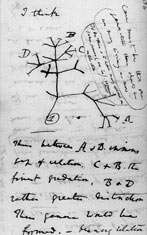January 27, 2009 weblog
Darwin's Tree of Life May Be More Like a Thicket

(PhysOrg.com) -- In On The Origin of Species, Darwin used the image of a tree of life to illustrate how species evolve, one from another. Even today, branches sprouting from lower branches (representing ancestors) is how many people view the evolution of species.
However, for some time, evolutionary biologists have known that the picture is not quite so clear. A recent feature article in New Scientist investigates the current views of biologists - that organisms may pass traits not just to their offspring, but to other living organisms - and suggests that uprooting the tree of life may be the start of a revolutionary change in biology.
The possibility that evolution isn't as clear as the tree of life is not a brand new idea to biologists, but it has slowly risen from various studies. In the 1950s and following decades, the discovery of DNA, RNA, and protein sequences revealed that species once thought to be near each other on the tree are in fact quite different, molecularly speaking. In the early '90s, scientists had hoped that gene sequencing would help them piece together the tree of life, but instead it showed conflicting results. For instance, some species that are closely related based on their DNA are not closely related at all based on their RNA.
In order to make sense of the conflicts, biologists had to reconstruct Darwin's tree, which assumed that organisms primarily pass their traits down to their offspring. Besides this "vertical" gene transfer, organisms may also share traits through "horizontal" gene transfer with other species, or even by reproducing with other species to produce genetic hybrids. Horizontal transfer and hybridization would result in a web of life, with species sharing some traits but not others, as the molecular evidence shows. Perhaps, the tree of life is just a way for humans to classify nature, as biologist W. Ford Doolittle has suggested.
Today, biologists disagree on whether horizontal gene transfer plays the prominent role in evolution, or if it just adds noise and makes it difficult to pinpoint the complex branching of the tree of life. Some scientists think that horizontal gene transfer may accurately explain the evolution of the simple organisms such as bacteria, archaea and prokaryotes such as amoeba, but that complex animals evolve vertically. But considering that these simple organisms make up 90% of all species, and have been around for 3.8 billion years whereas multi-cellular organisms appeared just 630 million years ago, a linear tree of complex creatures would be more like a small offshoot of the overall web.
But more recently, evidence suggests that complex organisms also have an evolutionary history of horizontal gene transfer and hybridization. It seems that viruses are constantly cutting and pasting DNA from one genome to another; in humans, up to half of our DNA may have been imported horizontally by viruses. In addition, hybridization occurs more commonly than previously thought. Evidence even shows that early Homo sapiens may have hybridized with some extinct related species, such as Homo erectus and the Neanderthals.
While this interrelatedness makes evolution more complex than originally thought, vertical processes still explain how multi-cellular organisms are related to each other pretty well - so the tree is still useful, but just for parts, not the whole. More significantly, understanding the complexity of evolution's branches may reveal that biology overall is more complex than it seems. As New Scientist points out, the field of biology is looking remarkably similar to that of physics around 1900 - just before groundbreaking discoveries in relativity and quantum mechanics revolutionized the field and the way we view the physical world.
via: New Scientist















